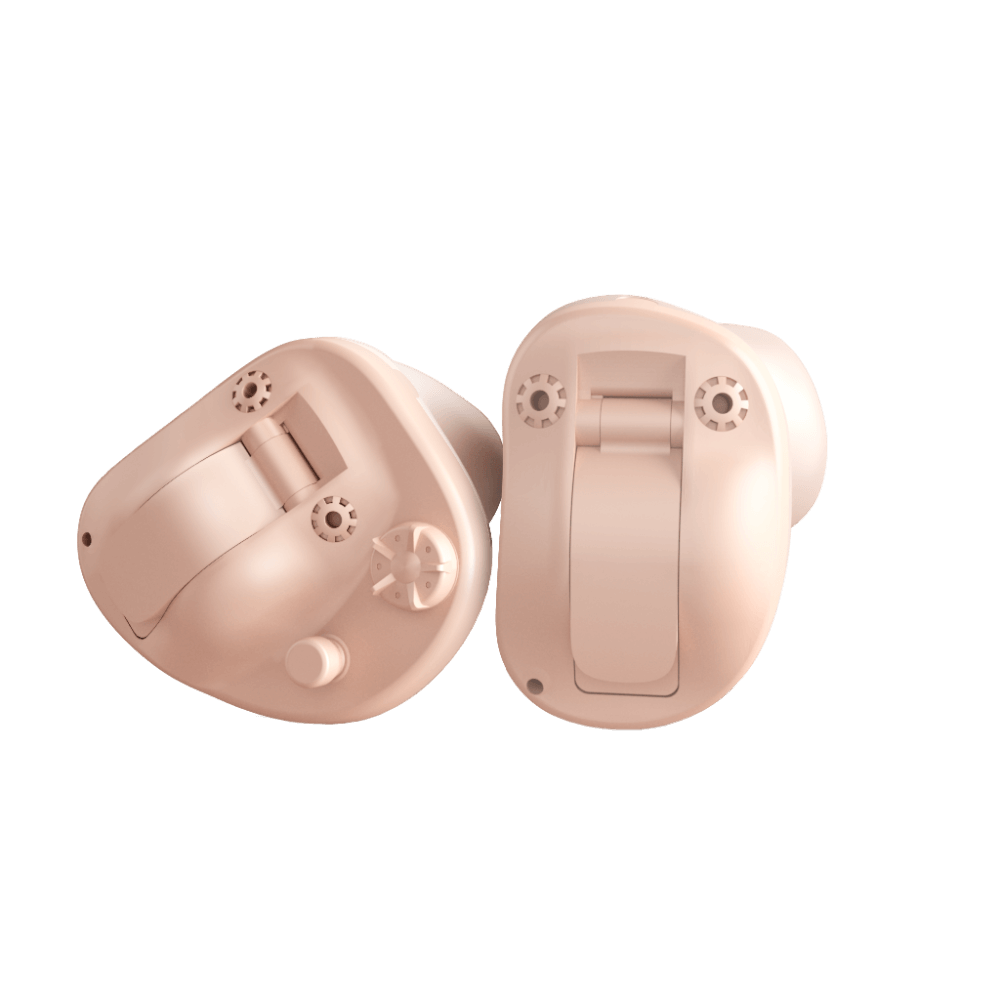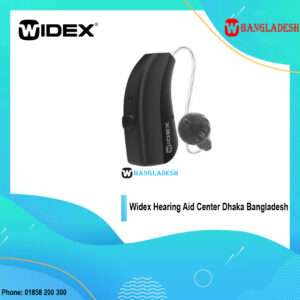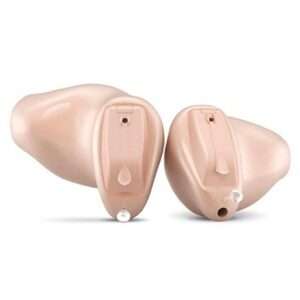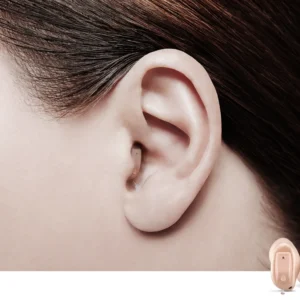What is an Widex In-The-Ear (ITE) hearing aid ?
Widex ITE hearing aid is a type of hearing aid that is custom-made to fit inside the ear canal of a person. “ITE” stands for “in-the-ear,” which means that the device is designed to be worn completely inside the ear.
Widex is a hearing aid manufacturer that produces a range of hearing aids including ITE hearing aids. These devices are custom-made to fit the unique shape of a person’s ear canal and can be used to treat a variety of hearing losses, from mild to severe.
The Widex ITE hearing aid uses advanced digital signal processing technology to amplify sounds and provide a clear and natural listening experience. These devices can be programmed by a hearing care professional to adjust to the specific hearing needs of the wearer.
Widex ITE hearing aids are available in different styles, such as completely-in-canal (CIC), in-the-canal (ITC), and full shell (FS), to cater to different preferences and levels of hearing loss.
How does Widex In-The-Ear (ITE) differ from other types of hearing aids?
Widex In-The-Ear (ITE) hearing aids differ from other types of hearing aids in several ways:
- Custom-fit: Unlike other types of hearing aids, ITE hearing aids are custom-made to fit inside the wearer’s ear canal. This makes them more comfortable to wear, and less visible than other types of hearing aids.
- Size: ITE hearing aids are generally smaller than other types of hearing aids, making them less obtrusive and easier to handle.
- Sound quality: Widex ITE hearing aids are designed to provide clear, natural sound quality, thanks to their advanced digital signal processing technology. This allows them to provide a more accurate representation of sounds, which can help wearers to better understand speech and other sounds.
- Battery life: Because they are smaller, ITE hearing aids tend to have smaller batteries than other types of hearing aids. However, advancements in battery technology have led to longer battery life in recent years.
- Level of amplification: ITE hearing aids can provide a high level of amplification, making them suitable for wearers with severe to profound hearing loss. However, they may not be as powerful as other types of hearing aids, such as behind-the-ear (BTE) or receiver-in-canal (RIC) hearing aids, which can provide even greater amplification.
Overall, Widex ITE hearing aids offer a discreet and comfortable solution for people with hearing loss, with advanced sound processing technology and customization options to meet individual needs.
What are the Advantages and Disadvantages of using an Widex In-The-Ear (ITE) Hearing Aid?
Advantages of using a Widex In-The-Ear (ITE) hearing aid include:
- Discreetness: The small size and custom-fit of an ITE hearing aid make it discreet and less visible compared to other types of hearing aids.
- Comfort: The custom-fit of an ITE hearing aid also makes it more comfortable to wear since it fits the unique shape of the wearer’s ear canal.
- Natural sound: Advanced digital signal processing technology in Widex ITE hearing aids provides clear, natural sound quality that can make it easier for wearers to understand speech and other sounds.
- Easy to handle: Due to their small size, ITE hearing aids are easy to handle and manipulate, making them a good choice for people with dexterity issues.
Disadvantages of using a Widex In-The-Ear (ITE) hearing aid include:
- Limited battery life: Due to their small size, ITE hearing aids have smaller batteries, which means they may need to be replaced or recharged more frequently than other types of hearing aids.
- Limited amplification: Although ITE hearing aids can provide a high level of amplification, they may not be as powerful as other types of hearing aids, such as behind-the-ear (BTE) or receiver-in-canal (RIC) hearing aids.
- Customization limitations: Since ITE hearing aids are custom-made, they may not be adjustable if the wearer’s hearing needs change over time.
- Vulnerability to earwax: ITE hearing aids are inserted into the ear canal, which can make them vulnerable to earwax buildup, which can affect their performance.
Overall, Widex ITE hearing aids offer a discreet and comfortable solution for people with hearing loss, but they may not be suitable for all types and levels of hearing loss. A hearing care professional can help determine if an ITE hearing aid is the right choice for a particular individual based on their hearing needs and preferences.
Who is a Good Candidate for Using an Widex In-The-Ear (ITE) Hearing Aid?
A good candidate for using a Widex In-The-Ear (ITE) hearing aid is someone with mild to severe hearing loss who values discreetness and comfort in a hearing aid. The custom-fit of an ITE hearing aid makes it a good option for people with smaller ear canals or those who may have difficulty manipulating larger hearing aids.
People who are looking for a hearing aid that is easy to handle and maintain may also benefit from an ITE hearing aid since they are small and easy to handle. Additionally, those who prefer a natural sound quality may appreciate the advanced digital signal processing technology in Widex ITE hearing aids, which can provide clear and natural sound.
However, people with severe to profound hearing loss may not find an ITE hearing aid to be powerful enough to meet their needs. Those who are prone to earwax buildup may also not be good candidates for an ITE hearing aid since it is inserted directly into the ear canal.
Ultimately, the best way to determine if a Widex ITE hearing aid is right for an individual is to consult with a hearing care professional who can perform a thorough hearing evaluation and recommend the most appropriate hearing aid based on the individual’s hearing needs and preferences.
How do I know if an Widex In-The-Ear (ITE) Hearing Aid is Right for me?
Choosing the right hearing aid is a personal decision that should be made with the help of a hearing care professional. However, here are some factors to consider when deciding if a Widex In-The-Ear (ITE) hearing aid is right for you:
- Your degree of hearing loss: ITE hearing aids are typically recommended for people with mild to severe hearing loss. If you have more severe hearing loss, you may need a more powerful hearing aid, such as a behind-the-ear (BTE) or receiver-in-canal (RIC) hearing aid.
- Your lifestyle and communication needs: If you value discreetness and comfort in a hearing aid and prefer a natural sound quality, a Widex ITE hearing aid may be a good choice for you. However, if you have an active lifestyle or frequently communicate in noisy environments, you may need a hearing aid with more advanced features to help you hear better in those situations.
- Your ear anatomy: Since ITE hearing aids are custom-made to fit inside the ear canal, your ear anatomy should be suitable for this type of hearing aid. People with narrow or irregularly-shaped ear canals may not be good candidates for an ITE hearing aid.
- Your dexterity: If you have difficulty handling small objects, an ITE hearing aid may not be the best choice for you since they are smaller and more delicate than other types of hearing aids.
- Your budget: ITE hearing aids can be more expensive than other types of hearing aids due to their custom-fit design. Make sure to consider your budget when deciding if a Widex ITE hearing aid is right for you.
Overall, the best way to know if a Widex ITE hearing aid is right for you is to consult with a hearing care professional. They can perform a comprehensive hearing evaluation and help you choose the hearing aid that best meets your individual needs and preferences.
What are the different styles of Widex In-The-Ear (ITE) Hearing Aids ?
Widex offers several different styles of In-The-Ear (ITE) hearing aids, each with unique features and benefits. Here are the main styles of Widex ITE hearing aids:
- Completely-In-Canal (CIC): CIC hearing aids are the smallest type of hearing aid and fit completely inside the ear canal. They are custom-made to fit the wearer’s ear canal, making them comfortable and discreet. CIC hearing aids are best suited for people with mild to moderate hearing loss.
- In-The-Canal (ITC): ITC hearing aids are slightly larger than CIC hearing aids and sit in the lower portion of the outer ear canal. They are also custom-made to fit the wearer’s ear canal, making them comfortable and discreet. ITC hearing aids are best suited for people with mild to moderately-severe hearing loss.
- Half-Shell: Half-shell hearing aids are larger than ITC hearing aids and fill up the lower portion of the outer ear. They are custom-made to fit the unique shape of the wearer’s ear and provide a comfortable fit. Half-shell hearing aids are best suited for people with mild to moderately-severe hearing loss.
- Full-Shell: Full-shell hearing aids are the largest type of ITE hearing aid and fill up the entire outer ear. They are custom-made to fit the wearer’s ear and provide a secure fit. Full-shell hearing aids are best suited for people with moderate to severe hearing loss.
Overall, the best style of Widex ITE hearing aid for an individual depends on their degree of hearing loss, ear anatomy, and personal preferences. A hearing care professional can help determine the most appropriate style of hearing aid based on a comprehensive hearing evaluation and the individual’s specific needs and preferences.
Which Widex In-The-Ear (ITE) is best for my needs?
Which Widex In-The-Ear (ITE) hearing aid is best for your needs since the best hearing aid for you depends on several factors, including your degree of hearing loss, ear anatomy, lifestyle, communication needs, and personal preferences. The best way to determine which Widex ITE hearing aid is best for your needs is to consult with a hearing care professional who can perform a comprehensive hearing evaluation and help you choose the hearing aid that best meets your individual needs and preferences.
During the hearing evaluation, the hearing care professional will assess your hearing loss, communication needs, and lifestyle to determine the most appropriate style of hearing aid for you. They will also take impressions of your ear canal to create a custom-fit hearing aid that fits comfortably and securely in your ear. Based on this information, the hearing care professional can recommend the best Widex ITE hearing aid model for your specific needs.
It is important to keep in mind that each person’s hearing loss and needs are unique, so the best Widex ITE hearing aid for one person may not be the best for another person. Therefore, it is crucial to work closely with a hearing care professional to find the best hearing aid for your individual needs.
How do I care for and maintain my Widex ITE hearing aid?
Proper care and maintenance of your Widex ITE hearing aid can help prolong its lifespan and ensure optimal performance. Here are some tips on how to care for and maintain your hearing aid:
- Clean your hearing aid daily: Use a soft, dry cloth or a special cleaning tool provided by your hearing care professional to wipe your hearing aid clean of earwax and debris. Avoid using water or other liquids, as this can damage the hearing aid.
- Keep your hearing aid dry: Remove your hearing aid before showering, swimming, or engaging in any water-based activities. If your hearing aid gets wet, dry it immediately with a soft, dry cloth.
- Handle your hearing aid carefully: Avoid dropping your hearing aid or exposing it to extreme temperatures or humidity. Store your hearing aid in a dry, cool place when not in use.
- Check the battery regularly: Make sure the battery is properly inserted and replace the battery as needed. Store batteries in a cool, dry place away from direct sunlight.
- Avoid exposing your hearing aid to chemicals: Avoid exposing your hearing aid to hairspray, perfume, or other chemicals that could damage the device.
- Schedule regular check-ups with your hearing care professional: Your hearing care professional can perform routine maintenance on your hearing aid and make any necessary adjustments to ensure optimal performance.
By following these care and maintenance tips, you can help ensure that your Widex ITE hearing aid performs at its best and lasts for many years to come.
Can I wear an Widex ITE hearing aid while sleeping or exercising?
It is generally not recommended to wear an Widex In-The-Ear (ITE) hearing aid while sleeping, as this can put pressure on the ear canal and cause discomfort or damage to the device. However, there may be some situations where wearing a hearing aid during sleep is necessary, such as for individuals who need to hear alarms or other sounds during the night. In these cases, it is important to consult with a hearing care professional to determine if wearing a hearing aid during sleep is safe and appropriate for you.
Regarding exercise, it is generally safe to wear an Widex ITE hearing aid during light exercise, such as walking or yoga. However, it is important to remove the hearing aid before engaging in any vigorous exercise, as sweat and moisture can damage the device. Additionally, it is important to take steps to protect the hearing aid from impact or damage during exercise, such as wearing a headband or protective gear.
Overall, it is important to follow the manufacturer’s guidelines and recommendations for wearing and caring for your Widex ITE hearing aid, and to consult with a hearing care professional if you have any questions or concerns about wearing your hearing aid during certain activities.
How long does the battery last in an Widex ITE hearing aid ?
The battery life of a Widex In-The-Ear (ITE) hearing aid can vary depending on the model, usage, and other factors. Typically, the battery life of a Widex ITE hearing aid ranges from 3 to 10 days.
The battery size of Widex ITE hearing aids can also vary, with smaller hearing aids typically using smaller batteries that may have a shorter lifespan. To extend the battery life of your Widex ITE hearing aid, it is recommended to turn off the hearing aid when it is not in use, and store it in a dry, cool place to help prevent moisture buildup that can drain the battery.
It is important to note that battery life can also be affected by factors such as the volume level of the hearing aid, the frequency of use, and the use of advanced features such as Bluetooth connectivity. Your hearing care professional can provide more information on the expected battery life of your specific Widex ITE hearing aid model and can help you choose the best battery type and size for your individual needs.
How often should I replace hearing aid batteries?
The frequency of replacing hearing aid batteries can vary depending on the type of hearing aid, battery size, usage, and other factors. In general, hearing aid batteries need to be replaced every 3 to 10 days, depending on the model and usage.
To determine when to replace your hearing aid battery, it is important to pay attention to the sound quality of your hearing aid. When the battery is low, you may notice that the sound becomes distorted or weak. Some hearing aids also have a low battery warning signal, such as a beep or tone, to alert you when it is time to replace the battery.
To extend the life of your hearing aid batteries, it is recommended to turn off your hearing aid when it is not in use and store it in a cool, dry place to help prevent moisture buildup that can drain the battery. It is also important to remove the battery from the hearing aid if you will not be using it for an extended period of time.
When it is time to replace your hearing aid battery, it is important to use the correct type and size of battery recommended by the manufacturer. Your hearing care professional can provide guidance on the best type of battery for your hearing aid and can help you learn how to properly replace the battery.
How do I adjust the volume or settings on my Widex ITE hearing aid?
The method for adjusting the volume or settings on your Widex In-The-Ear (ITE) hearing aid may vary depending on the specific model and features of your hearing aid. However, in general, the following steps can be used as a general guide:
- Locate the volume or program button on your hearing aid. This button may be located on the faceplate or on the back of the device, and may be labeled with a plus (+) and minus (-) sign.
- Press the plus (+) button to increase the volume or the minus (-) button to decrease the volume. You may hear a beep or tone to indicate that the volume has been adjusted.
- If your hearing aid has multiple programs or settings, you can cycle through them by pressing and holding the program button until you hear a beep or tone indicating that the program has changed.
- Some Widex ITE hearing aids may also have additional features or settings that can be adjusted using a smartphone app or other accessory. Your hearing care professional can provide guidance on how to use these features and adjust the settings on your specific hearing aid model.
It is important to refer to the user manual or consult with a hearing care professional for specific instructions on adjusting the settings on your Widex ITE hearing aid. Additionally, your hearing care professional can provide personalized guidance on how to optimize the settings for your individual hearing needs.




